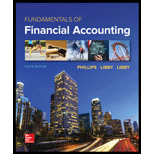
Concept explainers
Recording Transactions (in a Journal and T-Accounts); Preparing and Interpreting the
Ethan Allen Interiors Inc. is a leading manufacturer and retailer of home furnishings in the United States and abroad. The following is adapted from Ethan Allen’s September 30, 2016,

Assume that the following events occurred in the following quarter.
- a. Paid $30 cash for additional inventory.
- b. Issued additional shares of common stock for $20 in cash.
- c. Purchased equipment for $170; paid $60 in cash and signed a note to pay the remaining $110 in two years.
- d. Signed a short-term note to borrow $10 cash.
- e. Conducted negotiations to purchase a sawmill, which is expected to cost $36.
Required:
- 1. Calculate Ethan Allen’s
current ratio at September 30, 2016, prior to the transactions listed above. Based on this calculation and the analysis of TripAdvisor’s current ratio in the chapter, indicate which company is in a better position to pay liabilities as they come due in the next year. - 2. Analyze transactions (a)–(e) to determine their effects on the
accounting equation. Use the format shown in the demonstration case. - 3. Record the transaction effects determined in requirement 2 using journal entries.
- 4. Using the September 30, 2016, ending balances as the beginning balances for the October–December 2016 quarter, summarize the
journal entry effects from requirement 3. Use T-accounts if this requirement is being completed manually; if you are using the general ledger tool in Connect, the journal entries will have been posted automatically to general ledger accounts that are similar in appearance to Exhibit 2.9. - 5. Explain your response to event (e).
- 6. Prepare a classified balance sheet at December 31, 2016.
- 7. Use your response to requirement 6 to calculate Ethan Allen’s current ratio after the transactions listed in (a)–(e). Based on this calculation and the calculation in requirement 1, indicate whether the above transactions increase or decrease the company’s ability to pay current liabilities as they come due in the next year.
- 8. As of December 31, 2016, has the financing for Ethan Allen’s investment in assets primarily come from liabilities or stockholders’ equity?
1.
Ascertain the current ratio of Company E at September 30, 2016 and compare the current ratio of Company E with current ratio of Company T.
Explanation of Solution
Current Ratio: A part of liquidity ratios, current ratio reflects the ability to oblige the short term debts of a company. It is calculated based on the current assets and current liabilities; a company has in an accounting period. A current ratio is a useful tool for analysis of financials of a company.
Calculate the current ratio of Company E at September 30, 2016 as follows:
Here,
Current assets = $273 millions
Current liabilities= $135 millions
Therefore, the current ratio of Company E is 2.02.
Current ratio of Company E is 2.02 and Company T is 2.15, so Company E has less current ratio than Company T and this indicates that Company T has better position to repay the liabilities than Company E.
2.
Analyze the given transaction, and explain their effect on the accounting equation.
Explanation of Solution
Accounting equation: Accounting equation is an accounting tool expressed in the form of equation, by creating a relationship between the resources or assets of a company, and claims on the resources by the creditors and the owners. Accounting equation is expressed as shown below:
Accounting equation for each transaction is as follows:
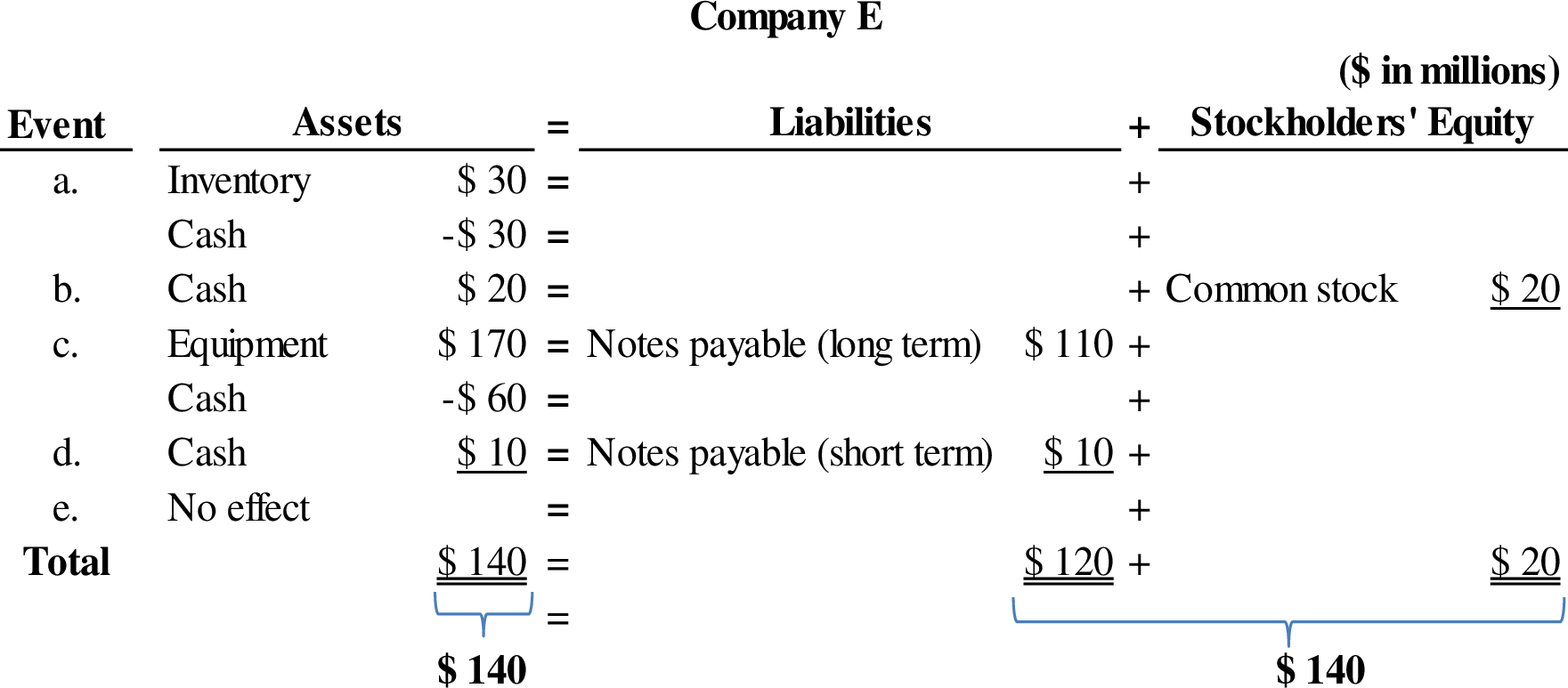
Figure (1)
Therefore, the total assets are equal to the liabilities and stockholder’s equity.
3.
Record the journal entries based on requirement 2.
Explanation of Solution
Journal: Journal is the method of recording monetary business transactions in chronological order. It records the debit and credit aspects of each transaction to abide by the double-entry system.
Rules of Debit and Credit:
Following rules are followed for debiting and crediting different accounts while they occur in business transactions:
- Debit, all increase in assets, expenses and dividends, all decrease in liabilities, revenues and stockholders’ equities.
- Credit, all increase in liabilities, revenues, and stockholders’ equities, all decrease in assets, and expenses.
Journal entries of Company E are as follows ($ in millions):
a. Inventories purchased in cash:
| Date | Accounts title and explanation | Ref. | Debit ($) | Credit ($) |
| Inventories (+A) | 30 | |||
| Cash (-A) | 30 | |||
| (To record purchase of supplies in cash) |
Table (1)
- Inventories are an assets account and it increases the value of asset by $30. Hence, debit the inventories account for $30.
- Cash is an assets account and it decreases the value of asset by $30. Hence, credit the cash account for $30.
b. Issuance of common stock:
| Date | Accounts title and explanation | Ref. | Debit ($) | Credit ($) |
| Cash (+A) | 20 | |||
| Common stock (+SE) | 20 | |||
| (To record the issuance of common stock) |
Table (2)
- Cash is an assets account and it increases the value of asset by $20. Hence, debit the cash account for $20.
- Common stock is a component of stockholder’s equity and it increases the value of stockholder’s equity by $20, Hence, credit the common stock account for $20.
c. Equipment purchased on account and in cash:
| Date | Accounts title and explanation | Ref. | Debit ($) | Credit ($) |
| Equipment (+A) | 170 | |||
| Cash (-A) | 60 | |||
| Notes payable (+L) | 110 | |||
| (To record the purchase of equipment on account and in cash) |
Table (3)
- Equipment is an assets account and it increases the value of asset by $170. Hence, debit the equipment account for $170.
- Cash is an assets account and it decreases the value of asset by $60. Hence, credit the cash account for $60.
- Notes payable is a liability account, and it increases the value of liabilities by $110. Hence, credit the notes payable account for $110.
d. Cash borrowed from bank (short term):
| Date | Accounts title and explanation | Ref. | Debit ($) | Credit ($) |
| Cash (+A) | 10 | |||
| Notes payable (+L) | 10 | |||
| (To record cash borrowed from bank) |
Table (4)
- Cash is an assets account and it increases the value of asset by $10. Hence, debit the cash account for $10.
- Notes payable is a liability account, and it increases the value of liabilities by $10. Hence, credit the notes payable for $10.
e. Conducted negotiations to purchase a saw mill:
For this case, no entry is required, because it is not a business transaction.
4.
Prepare T-account for each account listed in the requirement 2.
Explanation of Solution
T-account: T-account refers to an individual account, where the increases or decreases in the value of specific asset, liability, stockholder’s equity, revenue, and expenditure items are recorded.
This account is referred to as the T-account, because the alignment of the components of the account resembles the capital letter ‘T’.’ An account consists of the three main components which are as follows:
- (a) The title of the account
- (b) The left or debit side
- (c) The right or credit side
T-accounts of company E are as follows:
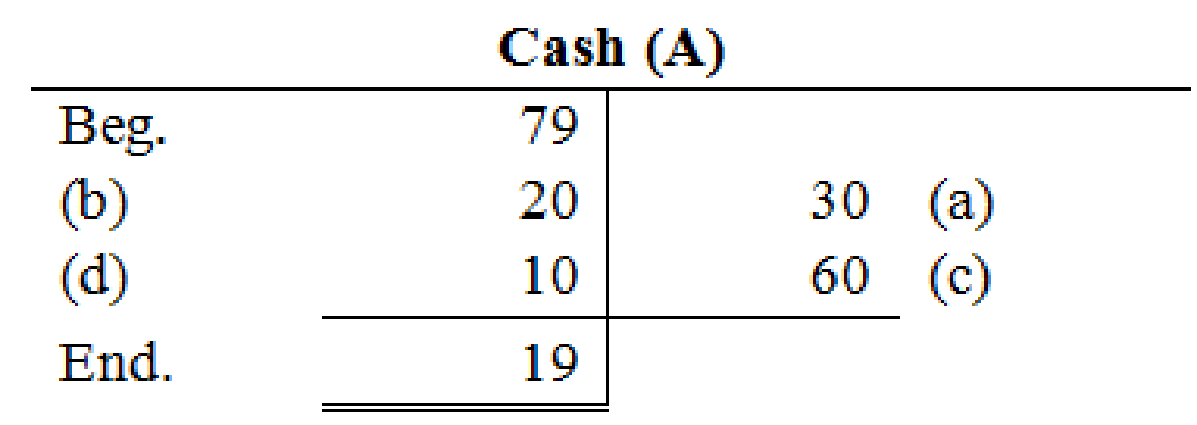
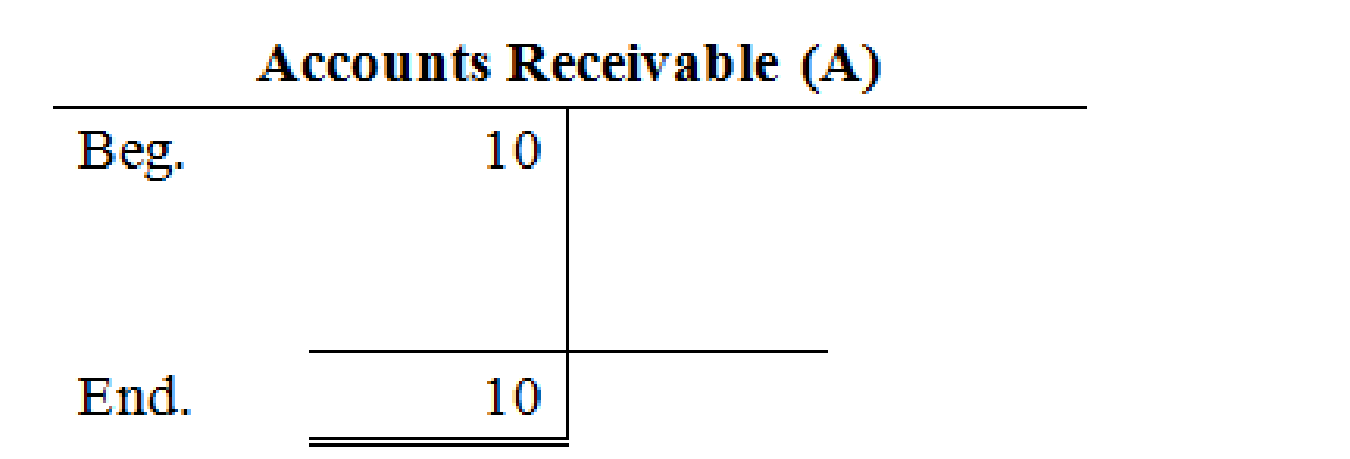
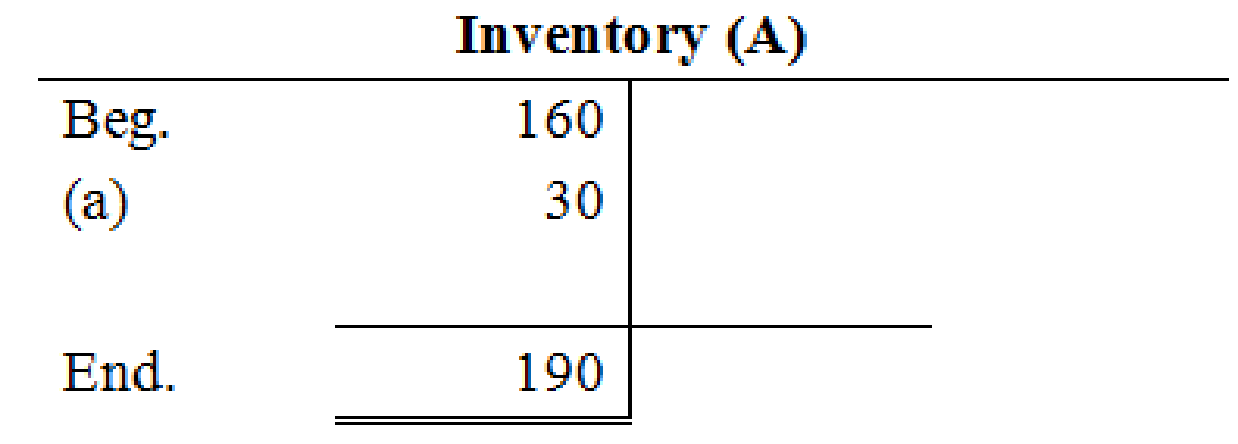




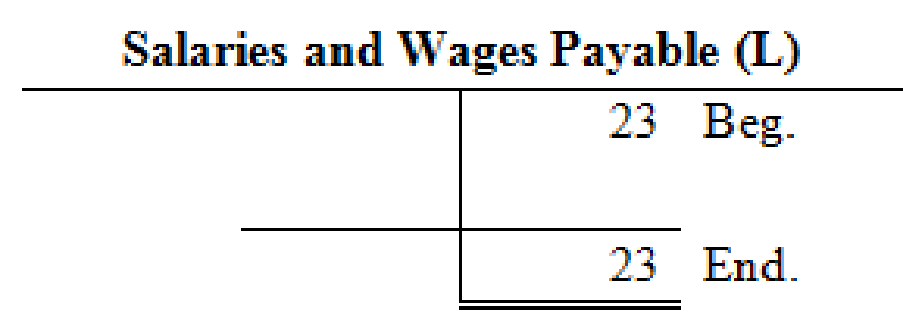


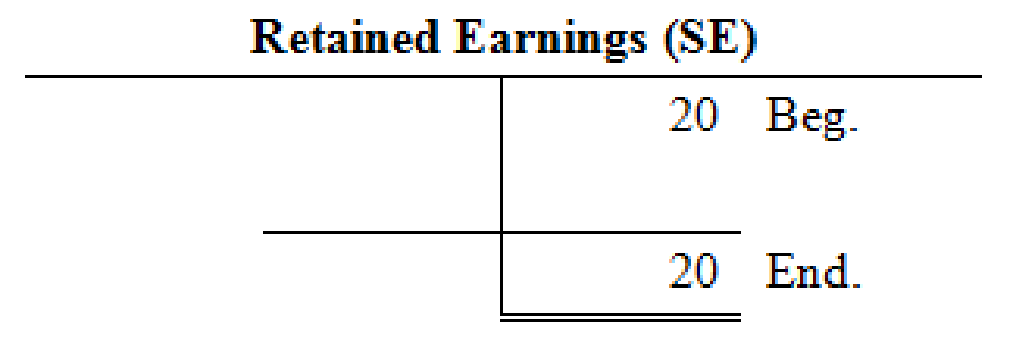
5.
Explain the appropriate response for event (e).
Explanation of Solution
Business transaction: Business transaction is a record of any economic activity, resulting in the change in the value of the assets, the liabilities, and the stockholder’s equities, of a business. Business transaction is also referred to as financial transaction.
Explain the appropriate response for event (e) as follows:
In this case, conducting negotiation to purchase a saw mill is not creating any impact on assets, liabilities and stockholder’s equity of the business, because it is not a business transaction.
6.
Prepare the classified balance sheet of Company E at December 31, 2016.
Explanation of Solution
Classified balance sheet: This is the financial statement of a company which shows the grouping of similar assets and liabilities under subheadings.
Classified balance sheet of Company E is as follows ($ in millions):
| Company E | ||
| Balance sheet | ||
| At December 31, 2016 | ||
| Assets | $(in millions | $(in millions |
| Current Assets: | ||
| Cash | 19 | |
| Accounts Receivable | 10 | |
| Inventory | 190 | |
| Prepaid Rent | 24 | |
| Total Current Assets | 243 | |
| Equipment | 443 | |
| Software | 45 | |
| Total Assets | 731 | |
| Liabilities | ||
| Current Liabilities: | ||
| Accounts Payable | 109 | |
| Salaries and Wages Payable | 23 | |
| Notes Payable (short-term) | 13 | |
| Total Current Liabilities | 145 | |
| Notes Payable (long-term) | 170 | |
| Total Liabilities | 315 | |
| Stockholders’ Equity: | ||
| Common Stock | 396 | |
| Retained Earnings | 20 | |
| Total Stockholders’ Equity | 416 | |
| Total Liabilities and Stockholders’ Equity | 731 | |
Table (1)
Therefore, the total assets of Company E are $731 million, and the total liabilities and stockholders’ equity is $731 million.
7.
Ascertain the current ratio of Company E based on requirement 6 and indicate whether the given transactions has increased or decreased the company’s ability to pay current liabilities.
Explanation of Solution
Ascertain the current ratio of Company E based on requirement 6 and indicate whether the given transactions has increased or decreased the company’s ability to pay current liabilities as follows:
Calculate the current ratio of Company E as follows (refer requirement 6):
Therefore, the current ratio of Company E at December 31, 2016 is 1.68.
Current ratio of Company E at December 31, 2016 (1.68) is less than the current ratio at September 30, 2016 (2.06). It clearly shows that the given transaction has decreased the company’s ability to pay its current liabilities.
8.
Indicate whether the total assets of Company E were primarily financed by liabilities or stockholder’s equity.
Explanation of Solution
Indicate whether the total assets of Company E were primarily financed by liabilities or stockholder’s equity as follows:
The invested amounts of assets primarily come from stockholder’s equity (common stock and retained earnings) of Company E, because stockholder’s equities (common stock) have financed $416 million of Company E’s total assets, whereas liabilities (non-current and current liabilities) have financed only $315 million.
Want to see more full solutions like this?
Chapter 2 Solutions
Loose Leaf For Fundamentals Of Financial Accounting
- Selected accounts and related amounts for Clairemont Co. for the fiscal year ended May 31, 2016, are presented in Problem 6-5A. Instructions 1. Prepare a single-step income statement in the format shown in Exhibit 11. 2. Prepare a statement of owners equity. 3. Prepare an account form of balance sheet, assuming that the current portion of the note payable is 50,000. 4. Prepare closing entries as of May 31, 2016.arrow_forwardThe transactions completed by PS Music during June 2018 were described at the end of Chapter 1. The following transactions were completed during July, the second month of the businesss operations: July 1. Peyton Smith made an additional investment in PS Musk in exchange for common stock by depositing 5,000 in PS Music s checking account. 1. Instead of continuing to share office space with a local real estate agency, Peyton decided to rent office space near a local music store. Paid rent for July, 1,750. 1. Paid a premium of 2,700 for a comprehensive insurance policy covering liability, theft, and fire. The policy covers a one-year period. 2. Received 1,000 on account. 3. On behalf of PS Music, Peyton signed a contract with a local radio station, KXMD, to provide guest spots for the next three months. The contract requires PS Music to provide a guest disc jockey for 80 hours per month for a monthly fee of 3,600. Any additional hours beyond 80 will be billed to KXMD at 40 per hour. In accordance with the contract, Peyton received 7,200 from KXMD as an advance payment for the first two months. 3. Paid 250 on account. 4. Paid an attorney 900 for reviewing the July 3 contract with KXMD. (Record as Miscellaneous Expense.) 5. Purchased office equipment on account from Office Mart, 7,500. 8. Paid for a newspaper advertisement, 200. 11. Received 1,000 for serving as a disc jockey for a party. 13. Paid 700 to a local audio electronics store for rental of digital recording equipment. 14. Paid wages of 1,200 to receptionist and part-time assistant. Enter the following transactions on lage 2 of the two-column journal: 16. Received 2,000 for serving as a disc jockey for a wedding reception. 18. Purchased supplies on account, 850. 21. Paid 620 to Upload Music for use of its current music demos in making various music sets. 22. Paid 800 to a local radio station to advertise the services of PS Music twice daily for the remainder of July. 23. Served as disc jockey for a party for 2,500. Received 750, with the remainder due August 4, 2018. 27. Paid electric bill, 915. 28. Paid wages of 1,200 to receptionist and part-time assistant. 29. Paid miscellaneous expenses, 540. 30. Served as a disc jockey for a charity ball for 1,500. Received 500, with the remainder due on August 9, 2018. 31. Received 3,000 for serving as a disc jockey for a party. July 31. Paid 1,400 royalties (music expense) to National Music Clearing for use of various artists music during July. 31. Paid dividends, 1,250. PS Musics chart of accounts and the balance of accounts as of July 1, 2018 (all normal balances), are as follows: 11 Cash 3,920 41 Fees Earned 6,200 12 Accounts Receivable 1,000 50 Wages Expense 400 14 Supplies 170 51 Office Rent Expense 800 15 Prepaid Insurance 52 Equipment Rent Expense 675 17 Office Equipment 53 Utilities Expense 300 21 Accounts Payable 250 54 Music Expense 1,590 23 Unearned Revenue 55 Advertising Expense 500 31 Common Stock 4,000 56 Supplies Expense 180 33 Dividends 500 59 Miscellaneous Expense 415 Instructions 1. Enter the July 1, 2018, account balances in the appropriate balance column of a four-column account. Write Balance in the Item column, and place a check mark () in the Posting Reference column. {Hint: Verify the equality of the debit and credit balances in the ledger before proceeding with the next instruction.) 2. Analyze and journalize each transaction in a two-column journal beginning on Page 1, omitting journal entry explanations. 3. Post the journal to the ledger, extending the account balance to the appropriate balance column after each posting. 4. Prepare an unadjusted trial balance as of July 31, 2018.arrow_forwardLowes Companies Inc., a major competitor of The Home Depot in the home improvement business, operates over 1,700 stores. Lowes recently reported the following balance sheet data (in millions): a. Determine the total stockholders equity at the end of Years 2 and 1. b. Determine the ratio of liabilities to stockholders equity for Year 2 and Year 1. Round to two decimal places. c. What conclusions regarding the risk to the creditors can you draw from (b)? d. Using the balance sheet data for The Home Depot in Exercise 1-26, how does the ratio of liabilities to stockholders equity of Lowes compare to that of The Home Depot?arrow_forward
- Using the income statement for Ousel Travel Service shown in Practice Exercise 1-4A, prepare a statement of owners equity for the year ended November 30, 2016. Shane Ousel, the owner, invested an additional 50,000 in the business during the year and withdrew cash of 30,000 for personal use. Shane Ousel, capital as of December 1, 2015, was 666,000.arrow_forwardAnalyzing Transactions. Using the analytical framework, indicate the effect of the following related transactions of a firm. a. January 1: Issued 10,000 shares of common stock for 50,000. b. January 1: Acquired a building costing 35,000, paying 5,000 in cash and borrowing the remainder from a bank. c. During the year: Acquired inventory costing 40,000 on account from various suppliers. d. During the year: Sold inventory costing 30,000 for 65,000 on account. e. During the year: Paid employees 15,000 as compensation for services rendered during the year. f. During the year: Collected 45,000 from customers related to sales on account. g. During the year: Paid merchandise suppliers 28,000 related to purchases on account. h. December 31: Recognized depreciation on the building of 7,000 for financial reporting. Depreciation expense for income tax purposes was 10,000. i. December 31: Recognized compensation for services rendered during the last week in December but not paid by year-end of 4,000. j. December 31: Recognized and paid interest on the bank loan in Part b of 2,400 for the year. k. Recognized income taxes on the net effect of the preceding transactions at an income tax rate of 40%. Assume that the firm pays cash immediately for any taxes currently due to the government.arrow_forwardThe transactions completed by AM Express Company during March 2016, the first month of the fiscal year, were as follows: Instructions 1. Enter the following account balances in the general ledger as of March 1: 2. Journalize the transactions for March 2016, using the following journals similar to those illustrated in this chapter: single-column revenue journal (p. 35), cash receipts journal (p. 31), purchases journal (p. 37, with columns for Accounts Payable, Maintenance Supplies, Office Supplies, and Other Accounts), cash payments journal (p. 34), and two-column general journal (p. 1). Assume that the daily postings to the individual accounts in the accounts payable subsidiary ledger and the accounts receivable subsidiary ledger have been made. 3. Post the appropriate individual entries to the general ledger. 4. Total each of the columns of the special journals, and post the appropriate totals to the general ledger; insert the account balances. 5. Prepare a trial balance.arrow_forward
- EFFECTS OF TRANSACTIONS (BALANCE SHEET ACCOUNTS) Jon Wallace started a business. During the first month (March 20--), the following transactions occurred. Show the effect of each transaction on the accounting equation: Assets= Liabilities + Owners Equity. After each transaction, show the new account totals. (a) Invested cash in the business, 30,000. (b) Bought office equipment on account, 4,500. (c) Bought office equipment for cash, 1,600. (d) Paid cash on account to supplier in transaction (b), 2,000. EFFECTS OF TRANSACTIONS (REVENUE, EXPENSE, WITHDRAWALS) This exercise is an extension of Exercise 2-3B. Lets assume Jon Wallace completed the following additional transactions during March. Show the effect of each transaction on the basic elements of the expanded accounting equation: Assets = Liabilities + Owners Equity (Capital Drawing + Revenues Expenses). After transaction (k), report the totals for each element. Demonstrate that the accounting equation has remained in balance. (e) Performed services and received cash, 3,000. (f) Paid rent for March, 1,000. (g) Paid March phone bill, 68. (h) Jon Wallace withdrew cash for personal use, 800. (i) Performed services for clients on account, 900. (j) Paid wages to part-time employee, 500. (k) Received cash for services performed on account in transaction (i), 500.arrow_forwardApex Systems Co. offers its services to residents in the Seattle area. Selected accounts from the ledger of Apex Systems Co. for the fiscal year ended December 31, 2016, are as follows: Prepare a statement of owners equity for the year.arrow_forwardSeth Feye established Reliance Financial Services on July 1, 2016. Reliance Financial Services offers financial planning advice to its clients. The effect of each transaction and the balances after each transaction for July follow: Instructions 1. Prepare an income statement for the month ended July 31, 2016. 2. Prepare a statement of owners equity for the month ended July 31, 2016. 3. Prepare a balance sheet as of July 31, 2016. 4. (Optional) Prepare a statement of cash flows for the month ending July 31, 2016.arrow_forward
- Discuss how each of the following transactions for Watson, International, will affect assets, liabilities, and stockholders equity, and prove the companys accounts will still be in balance. A. An investor invests an additional $25,000 into a company receiving stock in exchange. B. Services are performed for customers for a total of $4,500. Sixty percent was paid in cash, and the remaining customers asked to be billed. C. An electric bill was received for $35. Payment is due in thirty days. D. Part-time workers earned $750 and were paid. E. The electric bill in C is paid.arrow_forwardUsing the income statement for Sentinel Travel Service shown in Practice Exercise 1-4B, prepare a statement of owners equity for the year ended August 31, 2016. Barb Schroeder, the owner, invested an additional 36,000 in the business during the year and withdrew cash of 18,000 for personal use. Barb Schroeder, capital as of September 1, 2015, was 380,000.arrow_forward
 College Accounting, Chapters 1-27AccountingISBN:9781337794756Author:HEINTZ, James A.Publisher:Cengage Learning,Principles of Accounting Volume 1AccountingISBN:9781947172685Author:OpenStaxPublisher:OpenStax College
College Accounting, Chapters 1-27AccountingISBN:9781337794756Author:HEINTZ, James A.Publisher:Cengage Learning,Principles of Accounting Volume 1AccountingISBN:9781947172685Author:OpenStaxPublisher:OpenStax College Financial AccountingAccountingISBN:9781305088436Author:Carl Warren, Jim Reeve, Jonathan DuchacPublisher:Cengage Learning
Financial AccountingAccountingISBN:9781305088436Author:Carl Warren, Jim Reeve, Jonathan DuchacPublisher:Cengage Learning Financial Reporting, Financial Statement Analysis...FinanceISBN:9781285190907Author:James M. Wahlen, Stephen P. Baginski, Mark BradshawPublisher:Cengage Learning
Financial Reporting, Financial Statement Analysis...FinanceISBN:9781285190907Author:James M. Wahlen, Stephen P. Baginski, Mark BradshawPublisher:Cengage Learning Financial AccountingAccountingISBN:9781337272124Author:Carl Warren, James M. Reeve, Jonathan DuchacPublisher:Cengage Learning
Financial AccountingAccountingISBN:9781337272124Author:Carl Warren, James M. Reeve, Jonathan DuchacPublisher:Cengage Learning





